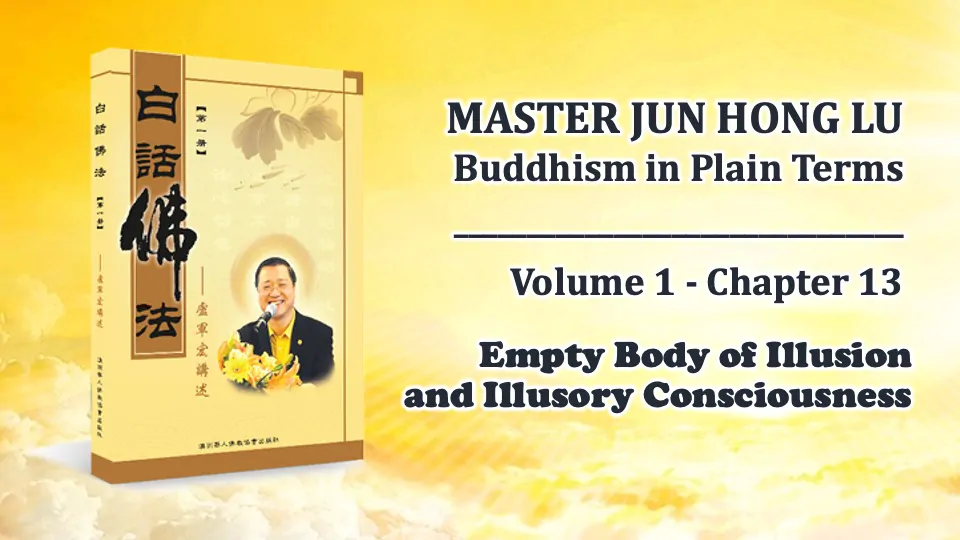According to the Buddha-dharma, “The empty body – an illusory transformation – is the dharma body.” This body is said to be empty, and – in fact – an illusion. It was formed by the temporary combination of the five aggregates: form, feelings, perceptions, mental formations and consciousness. After you die, this body will not even exist. In the Human Realm, we call this empty body of illusion the dharma body.
As the five aggregates are empty, and the four “great elements” (namely, earth, water, fire and wind) do not really exist, it is therefore called the empty body of illusion. Now, there’s a method that you can use to feel that your body is in fact empty. You can use this analytical approach to attain liberation and to realise that the human body is indeed empty by nature. For example, imagine a factory accident caused you to lose a hand, or a car accident has cost you a leg, and so on.
This body is unreal, so that when it’s gone, it’s simply gone. That is why we must not become obsessed with this body, which is simply a temporary combination of elements. Things that are not real will not last, so why don’t we try to cultivate what is real instead? Our minds and our spirit are real. They are something that can help us attain enlightenment through cultivation, and something that can truly stay with us.
Those learning Mahayana Buddhism should understand that, when encountering or responding to innumerable dharmas, their very substance is empty. Therefore, there’s no need to analyse. In other words, for all dharmas in the world, namely, everything that we see, we should understand that they are empty by nature. With this understanding, there is no need to analyse or even deal with them.
Our inherent nature originated from Buddha. But why does our natural dharma body consist of the five aggregates and the three poisons of greed, hatred and delusion? Why must the five aggregates in our dharma body be empty? Similarly, while the sun shines on the world and brings us light, why are there still dark clouds? It’s because of the combination of our natural body, the five aggregates and the three poisons, all existing in the Human Realm. Though your mind is kind-hearted, when you begin to hate it’s likened to being shaded by dark clouds. Or when you like something, but the frantic nature of your pursuit leads to your confusion.
What is consciousness, illusion and differentiation? Consciousness is what you think. Illusion is the illogical pursuit of something unreal. For example, you don’t have any money and yet you think constantly about winning the lottery. When there is change in your consciousness, you will embark on a path that deviates from reality – leading you to the world of illusion. Illusory consciousness is, at the core, misinterpretation.
How do we know when we fall into illusion? Before realising you are wrong, you must have reached a certain level of spirituality. For example, after learning Buddhism, you realise that you shouldn’t gamble or trade in shares – you shouldn’t rely on these things to make money.
To grow wealth, you should work earnestly, relying on your abilities rather than taking a shortcut. These shortcuts are categorised as “indirect wealth” in Buddhism, physiognomy or Book of Changes (an ancient Chinese divination text). Anything other than direct wealth is very short-lived. If you are yet to reach a certain level of spirituality, you may think that gambling and share-trading are also ways to make money.
Practising Buddhism is like planting trees – the roots must be deep. You must have a foundation when practicing Buddhism. With a solid foundation, your trees will be able to grow strong branches, healthy leaves and beautiful fruits. If you pursue only fame and fortune, that’s like walking to the top of a pyramid. The further you go up, the narrower the path becomes until the very top – where there’s no more road left to walk or stand on.
You can develop wisdom by practising Buddhism. It teaches you how to lay a solid foundation, which is likened to planting a tree that grows, becomes taller and more bountiful with marvellous fruit. It should not be like climbing a pyramid – where getting to the top is the end of the road. Buddhist practitioners must plant the trees of merit and virtue extensively, as this represents boundless merits and virtues.
Where does immeasurable merit and virtue come from? It comes from faith, sympathetic joy and gratitude.
1. Immeasurable merit and virtue stems from faith. If you want to perform meritorious deeds, you must first have faith. Believe in yourself and in Guan Yin Bodhisattva.
2. Sympathetic joy is the doing of good, whenever and wherever it is possible.
3. Gratitude. If you want to accumulate immeasurable and boundless merit and virtue, you must have faith. No matter what kinds of benevolent deeds you undertake, in good times or in adversity, we must be grateful to Guan Yin Bodhisattva, who helps us move through our lives in peace and good health every day. That’s why people who live in peace must be grateful! The immeasurable and boundless Buddha-dharma, immeasurable and boundless wisdom, and immeasurable and boundless merit and virtue are all accumulated one bit at a time. In the end, it becomes completely perfect.

